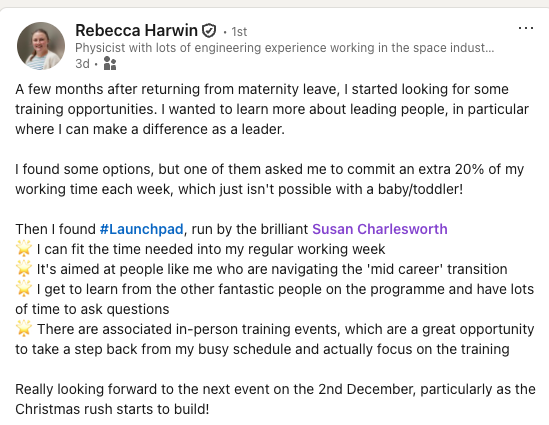Make an impact with basic leadership
Leadership isn't complicated. You can make an impact in an organisation by taking responsibility for a few simple things, no matter your level or role.

Your number one job as a leader is to take responsibility. That’s it. There are a thousand other things that go into leadership, but what separates leaders from everyone else is this one simple thing. If you understand this, you understand 90% of leadership all at once.
The problem is, taking responsibility is hard. Even though you already know what to do.
You know what it feels like when everyone in the room is itching for some clearer direction, or when no-one gets what the speaker is talking about. You can tell when teams are working at odds, when one isn’t talking to the other. You know you need to talk to one more person, and that you need to ask one more stupid question so you understand what your colleague is saying. You know their idea is best, and no one is listening to them.
You know all this but it doesn’t make it easy to take responsibility and do something about it.
It’s like running. No one needs to tell you how to run. You naturally know exactly what to do. But doing it is hard. The most important skill runners develop isn’t running itself, but the ability to overcome the discomfort of doing it at all. Once they have that, they just have to do a few basic things over and over again, and they are a runner.
Becoming a leader is exactly the same. You already know what to do. What you need to learn is how to overcome your own, internal, psychological resistance, and take responsibility for doing a few basic things over and over again.
Basic Leadership
I’ve been in leadership positions my entire professional career. I started in the Army (the infantry, no less), then moved on to managing IT projects, and R&D projects, and eventually managing engineering teams building software.
Everywhere I’ve worked I’ve seen the same thing. Leadership makes an impact. And good leadership isn’t complicated at all. Everyone benefits, universally, when people take responsibility for three basic things:
- Clarity
- Collaboration
- Decision making
No matter the workplace, these things seem uncomfortable enough that they don’t happen by accident, and universal enough that when people do take responsibility for them, they have a huge impact.
Anyone can take responsibility for these things. Any role, any organisation. That’s the beauty of our natural affinity for leadership. It doesn’t have to come with authority. Whenever it’s present, whoever it comes from, people respond.
What if you want it to come from you?
1. Clarity
Imagine how much energy is wasted by people trying to figure out what you mean when you don’t even know what you mean yourself.
You are responsible for the quality of your ideas. When they tumble out of your mind they aren’t complete, or even good. You certainly shouldn’t expect them to be ready for other people to consume until you’ve done some work on them. Whether you’re working alone or in a group, producing good ideas is vital.
This is hard because developing ideas takes criticism. Either you have to take the time yourself to be critical, or worse, you have to share your ideas with others so that they can criticise them. You could be in a rush. You could be in a heated discussion. You might find it difficult facing the limit of your knowledge. You might also be in a position of authority and feel threatened by criticism because of that.
You have to get over this.
Leadership is literally about ideas. That’s what people follow leaders for, and it’s what they collaborate on. If you can’t be clear, and if you can’t help other people be clear, then the very thing you’re all driving towards will be wrong.
How do you start being clearer?
Defeat your fear of criticism, with fallibilism.
People put on a good front when they present ideas. It can seem like they have everything figured out. They don’t. They’re guessing. Just like you. They’re also definitely wrong on some level. Fallibilism says there’s always more to learn, so we can’t possibly know anything for sure. Yes, all our models and methods and procedures work, but they can also always be improved. Everyone is in the same boat, so don’t worry. You can have good ideas AND they can be criticised. So get them out there.
Be someone who expects to work on ideas.
Since there will always be more to learn, and you’ll always be able to improve, there’s no such thing as a perfect answer. Instead, there’s a host of right answers, but you have to find them. This means you should’t feel disheartened when a great vision or plan doesn’t arrive in a flash of inspiration. But you also shouldn’t expect it to be easy. So if you want to make your ideas good, clear and thoughtful, expect to have to work on them.
Question authority.
People have a tradition of saying “because I say so”. But that’s not a good way to make a plan. Ideas should be intrinsically good. They should make sense without authority. And, as we’ve just discussed, authority has nothing to do with making sense. Something might be right today, in one context, but it won’t be right forever. So you have permission to ask questions to make sense of what you’re being told. Of course, sometimes you will be the one under time pressure and you’ll be tempted to say “Because I say so”. But that’s not what you mean. What you really mean is “Look, I’m sure this isn’t perfect but we have a lot to cover so we need to do it like this for now. Thanks!”.
Think about the quality of your ideas in terms of how clearly you can articulate them.
Not how subjectively or morally “good” they are. If you explain an idea to someone, could they actually do something about it? How many different ways could they interpret it? If your answer is “one” that’s good. If you’re not sure, then try harder.
Tactically, all of this shows up as being patient with yourself. Working on your ideas as they come to you, and driving towards clear answers by asking questions, even when you’re faced with authority. People don’t just appreciate the clarity. They need it. It’s a leaders responsibility to provide it.
2. Collaboration
Leadership isn’t about getting people to do things they wouldn’t otherwise do. Or persuading people that you’re right.
It’s about taking responsibility for producing the best possible ideas, which people can understand, follow, criticise and improve so that they are bought in, able to collaborate effectively, and therefore prepared to do something they wouldn’t otherwise do.
That’s a collaborative effort, because the best ideas probably won’t be yours, and that’s fine.
We resist collaboration for the same reasons we resist clarity. It’s uncomfortable working on things in public when they’re half baked and they can be criticised, and It can be hard for people with authority to be open to others. They might fear being undermined or looking weak. That’s what causes the typical autocratic meeting. The one way tirade of nonsense from the out of touch boss.
Time, logistics and social pressure also make unique contributions to thwarting collaboration. You mightn’t feel like you have enough time to bring everyone together, afraid you’ll create another round of failed democracy and delay important actions. You might literally not know who to speak to. The right group might seem too big (we all know one pizza teams are the limit these days) - best not speak at all.
You might also have politics (read: fear, greed and scarcity) to contend with. People might not actually want to openly collaborate, because you’re an enemy to them - they have their own agenda.
But collaboration is vital. So someone has to take responsibility for it.
Build a consensus
You have finite time and resources. Don’t waste them pulling in different directions. And don’t waste the human potential in your teams. People are magical. We’re all adaptable thinking machines that can achieve a lot with clear ideas. But when we take that same magic and spend it on unclear direction, we can do more harm than good. Teams can undermine each other, people can literally waste time, you can chase the wrong goals and ultimately fail for the wrong reasons. To get the most out of people, you are responsible for building consensus. Not in the political sense of all agreeing on a compromise. But in the practical sense. Everyone needs to understand what you’re all working towards, in as much detail as possible, so their contributions are pulling you in the right direction - always.
You see strong consensus building structures in leadership driven organisations. The military orders process is a perfect example. It’s a formal explanation of a commander’s plan, filled with context, double checking and even practical models, which every leader is responsible for delivering to their troops. It would be outrageous for a platoon to deploy on an operation without receiving orders first. It would be equally outrageous for the Platoon Commander to have someone else deliver those orders. That’s for a reason. They know that building consensus is vital, and it’s the leader’s responsibility to make it happen.
Create the best ideas
A lot of leaders emphasise the importance of getting buy-in as if it’s a clever trick. That you should make people feel included or heard so they work with a little more commitment. That’s a shame. What people really need is for you to listen to them and adapt the plan, the goal, or the aim based on what they tell you. What you really need is to get the best possible solution, no matter the source. You do that when you get people to collaborate freely, openly and clearly. That way, everyone who counts gets to craft your ideas together.
Be adaptable
Nothing ever goes to plan3. Indeed, planning and vision in general are more use as a direction than a destination. What you’re really doing is going the right way, rather than having a very specific end point in mind. Having a clear consensus on that direction helps people stay adaptable, because they can modify their actions and keep them aligned to the overall goal without checking a thousand times. You also need feedback to the group, so as people change their plans everyone else can adapt too.
You can help that to happen by establishing communication channels and willingly and openly feeding back updates so everyone takes it as normal and contributes themselves. You can make project review meetings purposeful by calling out delays. You can be the one gathering information for public updates. You just have to take responsibility for it.
3. Decision making
You don’t need to imagine how much energy and time is wasted waiting for clear decisions. I guarantee you’ve already felt the impact yourself at least once.
Decisions are just an extension of making yourself clear. Selecting one path from several, so that people can stay on track, or change course as necessary.
But, it’s psychologically hard to take responsibility for decisions because people are terrified of being wrong and the truth is, outcomes are always uncertain4. Of course, if you’re willing to take some responsibility, you can overcome that concern (for all the fallibilist reasons we’ve already discussed) and get people un-stuck.
Make decisions
The worst way to evade decisions is to say something that sounds like a decision, but isn’t. People in authority do this all the time. In sports we call this a hospital pass. What they say might be: “I need you guys to work together on this one, I know you’ll figure it out”. What they mean is “I don’t know, but I have to make it sound like I do, so now I’m going to let you fail, and pass it off as your fault”. Don’t do this. And don’t let it happen to you. State decisions clearly, so that they aren’t ambiguous, and you don’t leave people guessing what they should be doing.
Chart a course through the void
If you need people to make decisions and they aren’t, take that responsibility yourself. Say “Ok, I’m going to try this”. You’ll get one of two answers. Either your boss or team will say “NO!”, which is one kind of decision. Or they’ll say “Ok”. Which is another. Either way, you’ve broken the stalemate. And if the “No” answer leaves you back where you started, adrift, then at least you have an example of what a clear answer would be.
Get comfortable with risk
A lot of decisions are easier than they seem if you’re clear about the risk. Jeff Bezos has the concept of one way and two way doors. If something is irreversible, then deliberation is warranted. If it’s easy to roll something back, then just try it. A lot of things can be rolled back if you think about it. I’m sure there are plenty of delays caused for the sake of choosing between two options which could both have been tried faster than the end solution was eventually reached. Don’t be afraid to let experimentation do the heavy lifting. Remember, there are no perfect answers so you don’t need to justify yourself by having that perfect answer before you try something. It’s impossible. Just do it.
When you’re making decisions, you shouldn’t feel uncomfortable because you could be wrong. You should feel uncomfortable when you know people don’t actually know what they’re meant to be doing next.
Charlesworth Human Performance is a reader-supported publication. To receive new posts and support my work, consider becoming a free or paid subscriber.
You know what to do
Like I say, these are basics. You already know them. Either you’ve been on the receiving end of bad leadership, or you’ve been the one itching to say something but you haven’t quite built up the courage.
Courage is the operative word.
In the long tradition of leadership in the military, there are constant references to how important willpower is for leaders. It’s easy to think this is because Armies do especially tough stuff. That’s true. But it’s not the whole story. All leadership takes willpower. Whatever you’re doing you have to overcome your ego’s resistance and fear. But it’s worth it, because when you do, everyone gets the benefit.
- Be clear
- Collaborate
- Decide
Put one foot in front of the other, even though it feels uncomfortable.




